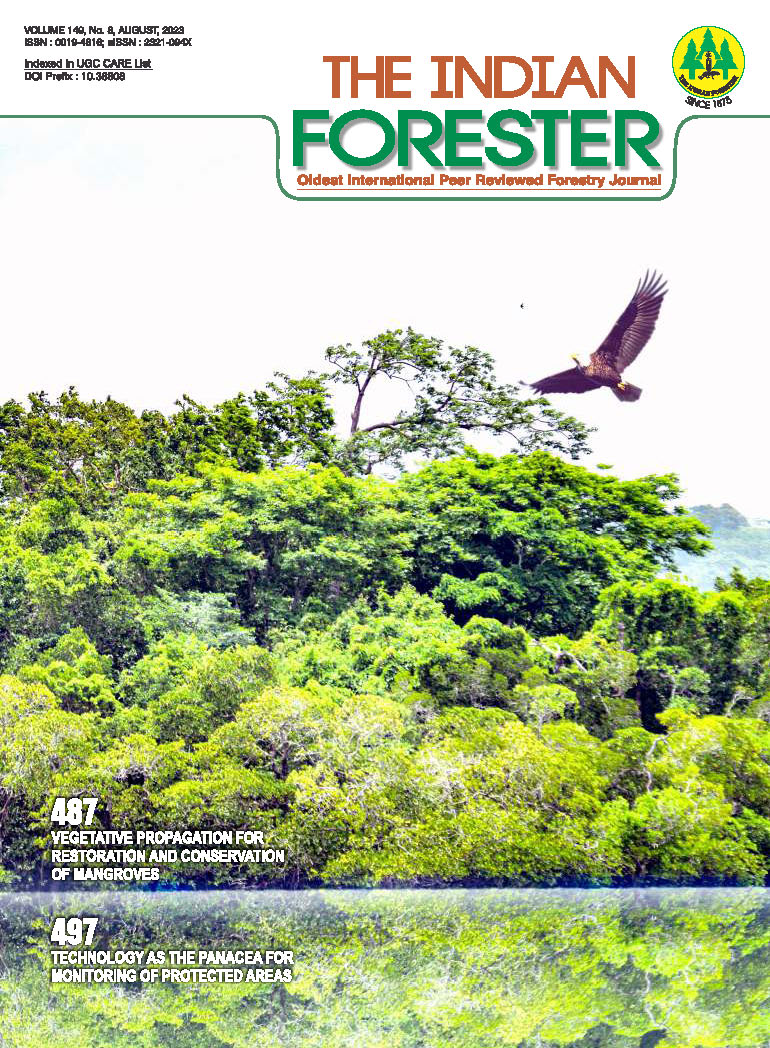Technology as the Panacea for Monitoring of Protected Areas
DOI:
https://doi.org/10.36808/if/2023/v149i8/169635Keywords:
Technological Advancement, Natural Resource Conservation, Ecological Monitoring, Illegal Practices.Abstract
The study highlights the use of technology in ensuring the protection of conservation sites such as forests and heritage sites. In this regard, the research utilizes a qualitative approach to assure that the latest technological advancements have a significant role to play in the monitoring and analysis of protected areas. Thus, the research outlines significant technologies, latest innovations, and upcoming plans to present the importance of technology in improving the monitoring of protected areas. In this context, the research adopts a qualitative research approach by interviewing conservation scientists, forest personnel, environmental researchers and managers of renowned technology companies, manufacturing innovative products that are sold for monitoring protected areas. The findings highlight the efficacy of technology in the conservation of natural resources. Additionally, certain recommendations concerning further improvement of monitoring of protected areas are also provided in the research paper.References
Araújo R. and Guimarães Vieira I.C. (2019). Deforestation and the ideologies of the frontier expansion: the case of criticism of the Brazilian Amazon monitoring program. Sustainability in Debate/Sustentabilidadeem Debate, 10(3): 354-365.
Azungah T. (2018). Qualitative research: deductive and inductive approaches to data analysis. Qualitative Research Journal, 18(4): 383-400. https://doi.org/10.1108/QRJ-D-18-00035.
Barratt M.J., Ferris J.A. and Lenton S. (2015). Hidden populations, online purposive sampling, and external validity: Taking off the blindfold. Field Methods, 27(1): 3-21.https://doi.org/10.1177/1525822X14526838.
Barry T.W.I.V. (2017). When Trash Costs Money: Analyzing the Impact of Pay-As-You-Throw Programs in Massachusetts. Journal of Environmental and Resource Economics at Colby, 4(1): 3.https://digitalcommons.colby.edu/jerec/vol4/iss1/3.
Bruno J.F., Côté I.M. and Toth L.T. (2019). Climate change, coral loss, and the curious case of the parrotfish paradigm: why don't marine protected areas improve reef resilience? Annual review of marine science, 11(1): 307-334. https://doi.org/10.1146/annurev-marine-010318-095300.
Davis C., Petersen R. and Thau D. (2014). New Technology Can Help Ensure that Protected Areas Stay Protected. [online] World Resources Institute. Available at: <https://www.wri.org/insights/new-technology-can-help-ensure-protected-areas-stay-protected> [Accessed 18 August 2021].
Dunn D.C., Jablonicky C., Crespo G.O., McCauley D.J., Kroodsma D.A., Boerder K., Gjerde K.M. and Halpin P.N. (2018). Empowering high seas governance with satellite vessel tracking data. Fish and Fisheries, 19(4): 729-739. https://doi.org/10.1111/faf.12285.
Gillespie T.W., Ostermann-Kelm S., Dong C., Willis K.S., Okin G.S. and MacDonald G.M. (2018). Monitoring changes of NDVI in protected areas of southern California. Ecological Indicators, 88: 485-494.https://doi.org/10.1016/j.ecolind.2018.01.031.
Goduka N. (2012). From positivism to indigenous science: A reflection on world views, paradigms and philosophical assumptions. Africa Insight, 41(4): 123-138. Available at https://hdl.handle.net/10520/EJC119962.
Gwal P., Lodhiyal N. and Rawat Y.S. (2021). Assessment of Biomass Storage, Net Accumulation and Carbon Sequestration in ChirPine (Pinus roxburghii Sarg.) Dominated Community Forests of Kumaun Himalaya in relation to Climate Change. Indian Forester, 147(7): 607-614.
Hively W.D., Shermeyer J., Lamb B.T., Daughtry C.T., Quemada M. and Keppler J. (2019). Mapping crop residue by combining Landsat and WorldView-3 satellite imagery. Remote Sensing, 11(16): 1857.https://doi.org/10.3390/rs11161857.
Jiménez López J. and Mulero-Pázmány M. (2019). Drones for conservation in protected areas: present and future. Drones, 3(1): 10.https://doi.org/10.3390/drones3010010.
Jones T.L., Baxter M.A.J. and Khanduja V. (2013). Aquick guide to survey research. The Annals of The Royal College of Surgeons of England, 95(1): 5-7.https://doi.org/10.1308/003588414X13824511649454.
Marvin D.C., Koh L.P., Lynam A.J., Wich S., Davies A.B., Krishnamurthy R., Stokes E., Starkey R. and Asner G.P. (2016). Integrating technologies for scalable ecology and conservation. Global Ecology and Conservation, 7: 262-275. https://doi.org/10.1016/j.gecco.2016.07.002.
Mascia M.B., Fox H.E., Glew L., Ahmadia G.N., Agrawal A., Barnes M., Basurto X., Craigie I., Darling E., Geldmann J. and Gill D. (2017). A novel framework for analyzing conservation impacts: evaluation, theory, and marine protected areas. Annals of the New York Academy of Sciences, 1399: 93-115.http://doi.org/10.1111/nyas.13428.
Palmer C. (2018). Can technology save life on Earth? [online] World Economic Forum. Available at: <https://www.weforum.org/agenda/2018/09/can-technology-save-life-on-earth/> [Accessed 18 August 2021].
Palminteri S. (2018). 10 top conservation tech innovations from 2017. [online] Mongabay Environmental News. Available at: <https://news.mongabay.com/2018/01/10-top-conservation-tech-innovations-from-2017/> [Accessed 18 August 2021].
Pintea L., Jantz S.M. and Wich S.A. (2021). From the cloud to the ground: converting satellite data into conservation decisions. In: Conservation Technology (S. A. Wich and A. K. Piel, Eds.), Oxford Press, pp. 13-34.
Ponto J. (2015). Understanding and evaluating survey research. Journal of the Advanced Practitioner in Oncology, 6(2): 168-171.PMID: 26649250; PMCID: PMC4601897.
Queensland Government (2019). Technology helps maintain our natural biodiversity. [online] Advance Queensland. Avai lable at: <https://advance.qld.gov.au/whats-happening/stories-about-innovation/technology-helps-maintain-our-natural-biodiversity> [Accessed 18 August 2021].
Zhang D., Wang H., Wang X. and Lü Z. (2020). Accuracy assessment of the global forest watch tree cover 2000 in China. International Journal of Applied Earth Observation and Geoinformation, 87: 102033.https://doi.org/10.1016/j.jag.2019.102033.
Downloads
Downloads
Published
How to Cite
Issue
Section
License
Unless otherwise stated, copyright or similar rights in all materials presented on the site, including graphical images, are owned by Indian Forester.





